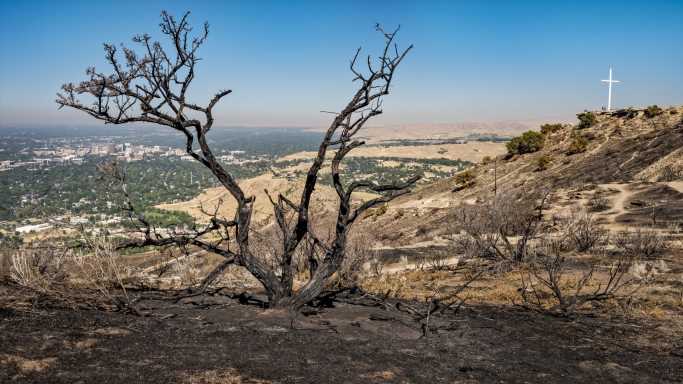Wildfires in Canada this week sent gigantic plumes of smoke into the air, which eventually made their way into the northeastern United States. The result was images of places like New York City drenched in an apocalyptic hazy glow and with hazardous air quality for days.
There’s always been fire in the world — ignited by lightning strikes, heat, or even lava flow. Human beings first learned how to control this mighty force of nature — how to start and stop fire and use it for their own purposes — as far back as a million years ago. This had a major impact on our evolutionary development, providing us with warmth and enabling us to cook our food (which increased its nutritional value and helped our brains grow larger).
The fact that we know how to control fire, of course, doesn’t mean that we always can control it. Lightning, heat, lava, and chemical reactions still set fires raging, as does simple human carelessness or even malice. Conflagrations in urban settings are usually extinguished fairly quickly, thanks to nearby fire departments and ready water supplies. Fires in the wild — including so-called brush fires and forest fires — are another story.
The Federal Emergency Management Agency (FEMA) defines a wildfire as “an unplanned fire that burns in a natural area such as a forest, grassland, or prairie” — though these blazes also often sweep through agricultural areas, residential neighborhoods, and even beach resorts (as with the fires in Greece this summer).
There are typically 100,000 wildfires a year just in the United States alone, and according to a 2015 study funded by the National Oceanic Atmospheric Administration (NOAA), the effects of climate change will probably greatly increase the number and magnitude of these fires over the next few decades.
Climate isn’t the main problem, though, nor are natural phenomena. The overwhelming majority of wildfires — some 90% — are caused by human beings. Discarded cigarettes and matches, unattended campfires, fireworks, trash burning, even sparks from a wheel rim being dragged across asphalt — and of course arson — are among the main causes of wildfires.
Feeding on dry scrub, timber, and other combustibles and whipped up by the wind, wildfires can spread with frightening speed. They are calamitous events, destroying homes and other buildings, killing animals and vegetation and people, polluting the environment, and often stripping nutrients from the soil so that regeneration is impossible. They can also, though, have a kind of hellish beauty as they blaze.
With that in mind, 24/7 Wall St. has gathered before and after photographs of 14 of the world’s worst wildfires — judged by number of fatalities or Area burned or both — of the 21st century, showing what the affected landscapes looked like before fire struck and then what they looked like burning, or in the blaze’s aftermath.
Click here for before and after pictures of devastating wildfires around the world.
To assemble a list of the world’s worst wildfires over the past 30 years, 24/7 Wall St. consulted websites of the World Resources Institute’s Global Forest Watch Fires, the National Fire Protection Association, the National Interagency Fire Center, and The Canadian Institute of Forestry’s Forestry Chronicle, as well as the Mother Nature Network, Worldatlas.com, Agence France-Presse (AFP), and “The Worst Wildfires of All Time” by Suzanne Garbe (Capstone Press).
In some cases, rather than individual blazes, these are wildfire complexes (two or more simultaneous neighboring fires) or larger series of fires.
Sponsored: Tips for Investing
A financial advisor can help you understand the advantages and disadvantages of investment properties. Finding a qualified financial advisor doesn’t have to be hard. SmartAsset’s free tool matches you with up to three financial advisors who serve your area, and you can interview your advisor matches at no cost to decide which one is right for you. If you’re ready to find an advisor who can help you achieve your financial goals, get started now.
Investing in real estate can diversify your portfolio. But expanding your horizons may add additional costs. If you’re an investor looking to minimize expenses, consider checking out online brokerages. They often offer low investment fees, helping you maximize your profit.
Source: Read Full Article
-
Disney CEO Bob Iger Calls “Retaliation” By Gov. Ron DeSantis “Not Only Anti-Business, But Anti-Florida”
-
Paid Late, or Never: Painters, Builders and Realtors Hit by China’s Property Crisis
-
Demand for white-collar gig roles rises 11% YoY in March 2023: Foundit.in
-
‘The Thanksgiving Play’ Sets Broadway Cast: D’Arcy Carden, Katie Finneran, Scott Foley & Chris Sullivan
-
U.S. Weekly Jobless Claims Inch Slightly Higher

